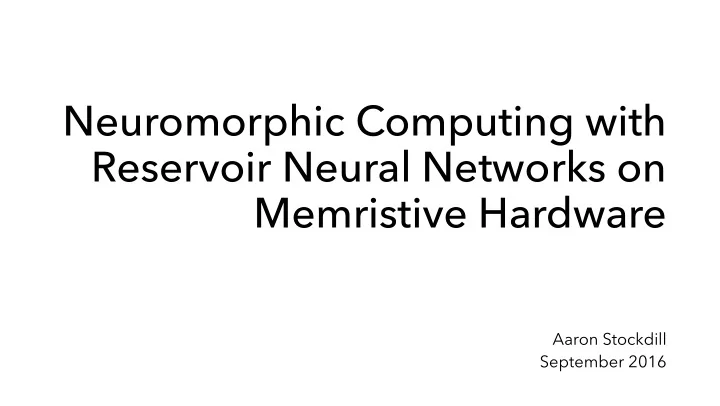

Neuromorphic Computing with Reservoir Neural Networks on Memristive Hardware Aaron Stockdill September 2016
Neuromorphic Computing with Reservoir Neural Networks on Memristive Hardware Aaron Stockdill September 2016
Neuromorphic Computing Brain Shaped Trying to build an artificial brain Software: Artificial Neural Networks Hardware: this project! Image Source: Middleton Lab, http://middleton-lab.com/
Reservoir Neural Networks Inputs Reservior Outputs Recurrent neural network Much easier to train — single readout layer ... ... Echo State Network (ESN), Jaeger, 2001 Liquid State Machine (LSM), Maass, 2002 W in W W out
Memristors & Atomic Switches V I Memristors: Leon Chua, 1989 Resistor Resistance is based on past voltage/current Capacitor Inductor Atomic switches are very similar, but instead of a gradual change, it’s high/low. Memristor Φ Q
Memristors & Atomic Switches 0 . 0010 0 . 10 0 . 0005 0 . 05 Current I Current I 0 . 0000 0 . 00 Resistor Memristor − 0 . 05 − 0 . 0005 − 0 . 10 − 0 . 0010 − 1 . 0 − 0 . 5 0 . 0 0 . 5 1 . 0 − 1 . 0 − 0 . 5 0 . 0 0 . 5 1 . 0 Voltage V Voltage V 10 0 . 4 5 0 . 2 Current I Current I 0 0 . 0 Atomic Switch Echo Neuron − 0 . 2 − 5 − 0 . 4 − 10 − 1 . 0 − 0 . 5 0 . 0 0 . 5 1 . 0 − 1 . 0 − 0 . 5 0 . 0 0 . 5 1 . 0 Voltage V Voltage V
Motivation & Goals Build a simulation of neuromorphic hardware See how atomic switches compare to memristors Determine what kinds of problems this hardware can solve Build the most amazing machine learning tool ever
Simulating Novel Hardware
Fostner & Brown Focussed only on atomic switches Matlab Workflow: • Deposit particles • Find groups • Calculate connections between groups. Image Source: Fostner & Brown, Neuromorphic behavior in percolating nanoparticle films
Statistical Depositions ● ● Size 8000 ● ● 20 ● Depositing individual particles ● 40 ● ● 60 ● 80 ● ● is really, really slow ● ● ● 100 ● ● 6000 120 ● ● ● ● Average number of groups 140 ● 160 ● ● ● ● ● ● ● 180 ● Use distributions around known ● ● 200 ● ● ● 4000 ● ● ● ● ● averages to “guess” groups ● ● ● ● ● ● ● ● ● ● ● ● ● ● ● ● ● ● ● ● ● 2000 ● ● ● ● Same trick for the gaps ● ● ● ● ● ● ● ● ● ● ● ● ● ● ● ● ● ● ● ● ● between them ● ● ● ● ● ● ● ● ● ● ● ● ● ● ● ● ● ● ● ● ● ● ● ● ● ● ● ● ● ● ● ● ● ● ● ● ● ● ● ● ● ● ● ● ● ● ● ● ● ● ● ● ● ● ● 0 0.1 0.2 0.3 0.4 0.5 0.6 0.7 Coverage
Statistical Depositions Networks can be generated quickly Nodes of the graph are the group centroids Edges are the memristive connections between the groups.
Kirchhoff’s Laws Current Law & Voltage Laws: • Current In = Current Out • Use all the voltage Used for circuit simulation Build a big matrix
Constructing a Reservoir ... ... W W W
Framework ... ... W W W Swap out each section as needed. Many variations tested quickly.
Readout Weights Ridge regression to penalise high weights Simple, linear optimisation Actually very powerful in its own right
Faster in Fortran Based on: d -length input sequence, n groups on the chip, k loops to solve the DE for memristors, Lower bounded by LU matrix decomposition. Slowest sections are now in Fortran!
Comparisons and Results Image Source: MicroAssist, licensed under CC-BY-SA.
Handwriting Recognition Memristors No reservoir at all 90%, Woohoo! It works! 90%, Oh no! It still works!
Mackey-Glass Echo State Network Memristors
Memory Echo state networks have four distinct sources of memory: • Leaking • Cycles • Loops • Discrete time steps Memristive networks have two sources of memory: • Leaking • Conductive state
One-hop ESN ESN* Cycles Memristors Loops ESN * Loops and Cycles can Broken mimic each ESN* Feed-forward other ESN + Discrete + Č er ň ansky Time and Makula
Summary
Summary We can speed up simulations with statistics Homogeneous neuromorphic hardware is missing key features Cycles can mimic loops, and loops can mimic cycles Discrete time is the single most important part of reservoir learners
Future Work Other network components: the ESN “IV” curve looks like a capacitor or inductor IV curve 0 . 4 Heterogenous networks with “neurons,” e.g. 0 . 2 Current I delay mechanisms 0 . 0 − 0 . 2 Alternative information encoding that the − 0 . 4 network may be able to handle better − 1 . 0 − 0 . 5 0 . 0 0 . 5 1 . 0 Voltage V Specialised hardware layout: Solving mazes with memristors: A massively parallel approach - Pershin and Di Ventra
Neuromorphic Computing with Reservoir Neural Networks on Memristive Hardware Aaron Stockdill September 2016
Recommend
More recommend